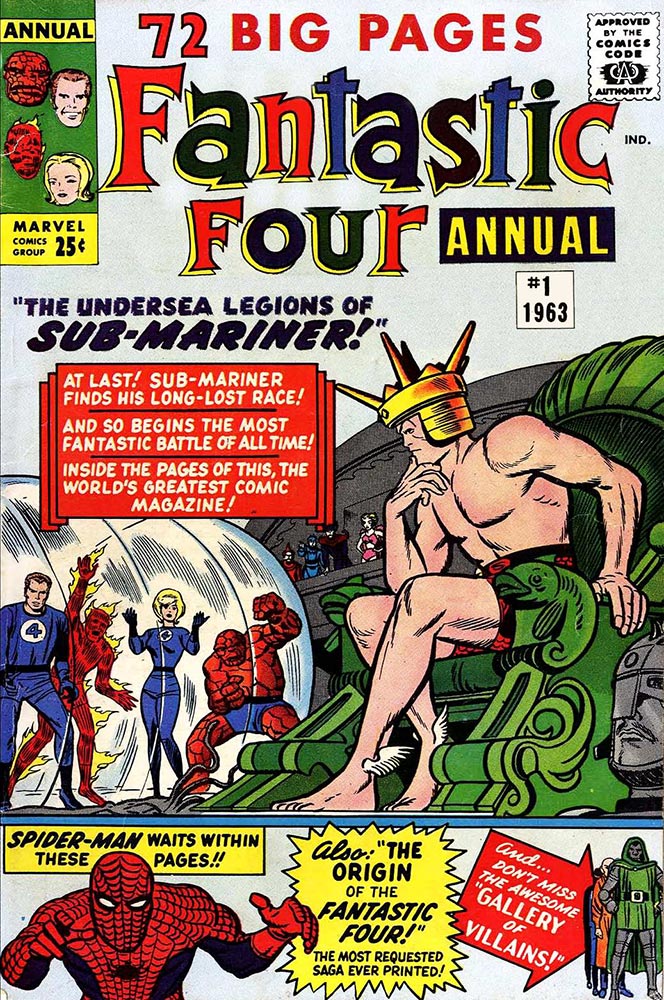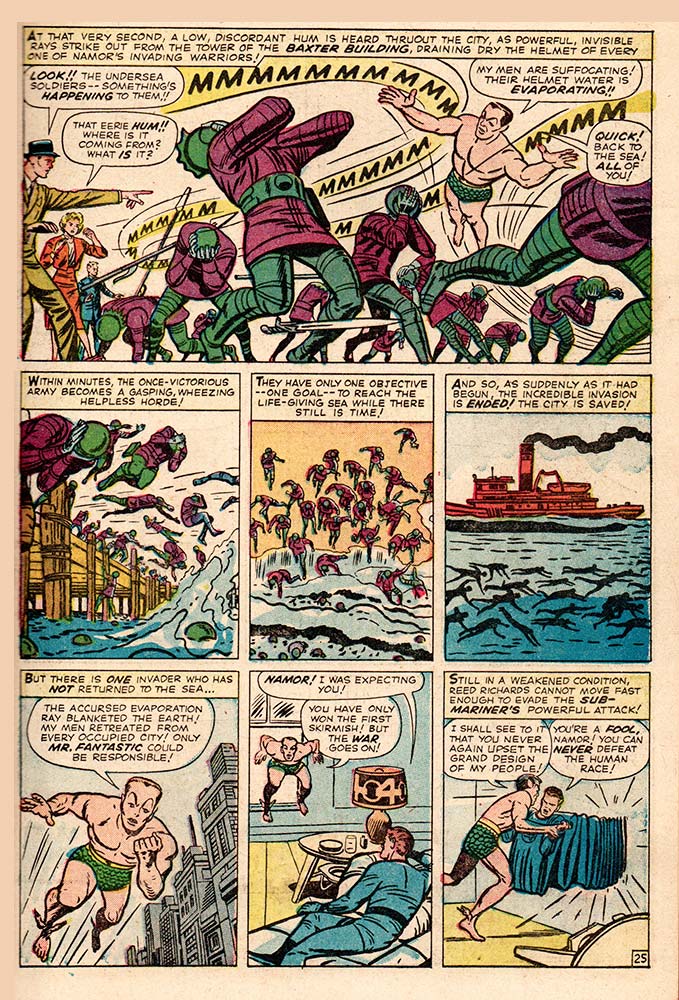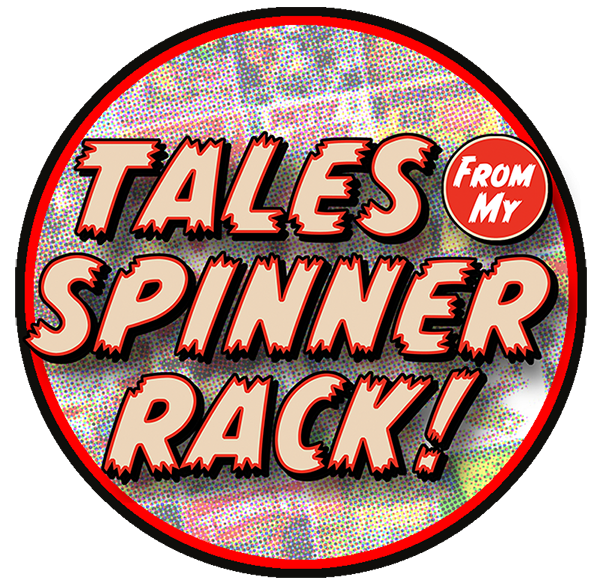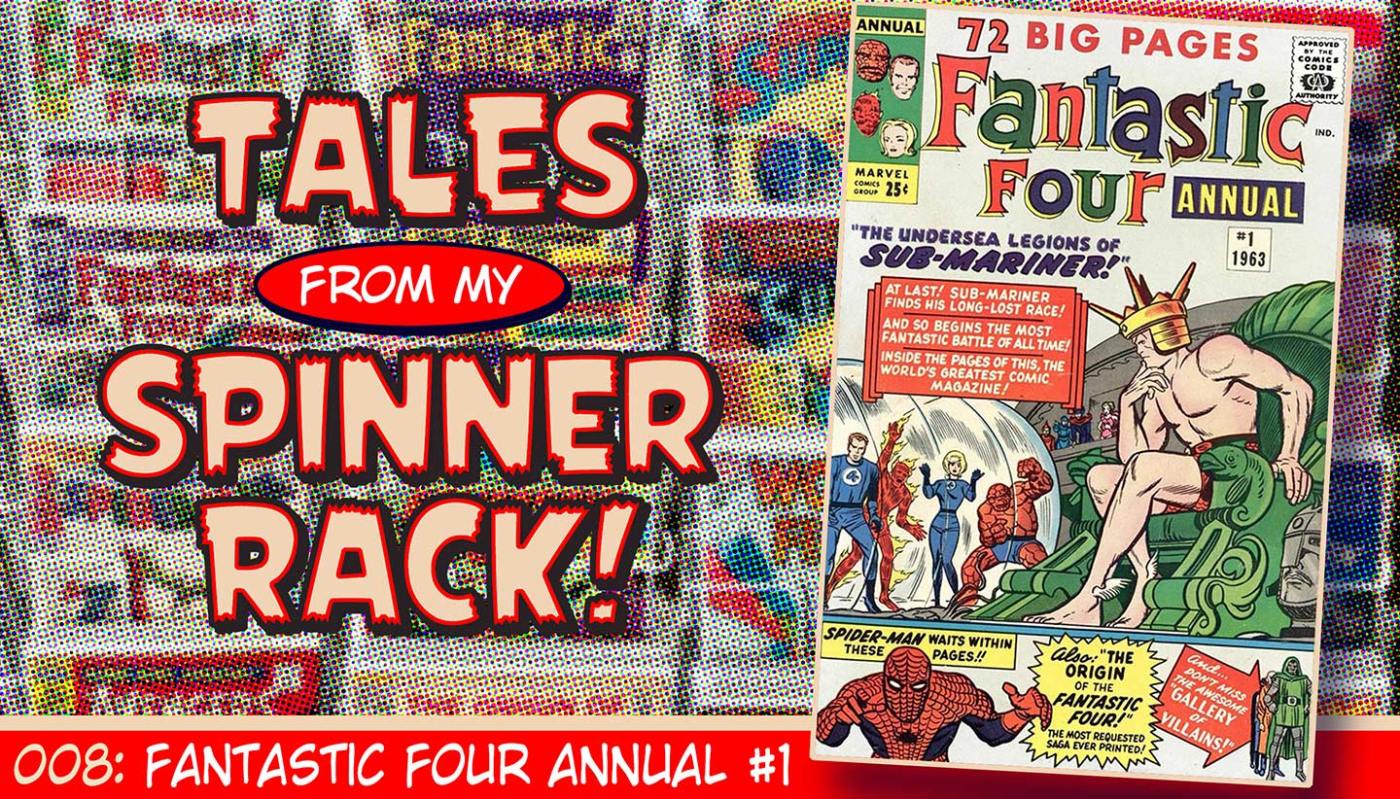Fantastic Four Annual #1, July 1963. Cover by Jack Kirby and Dick Ayers. TM & © MARVEL.
Click on the images in this post to see them larger on your screen!
I cannot begin to tell you how excited 8-year-old me was to find out there was a Fantastic Four Annual coming out in the summer of 1963. I had just turned that wise and august age, already a connoisseur of fine funny book art and stories, especially those of the Marvel variety. FF Annual #1 wasn’t my first annual. Oh, no … I had some experience in the world of giant 25-cent comics, especially those that appeared once a year and seemed oh, so special.



A house ad in DC Comics promoting Superman Annual #1; the Annual itself, with that iconic Curt Swan cover; and the first BIG Strange Tales Annual #1. Even when these books reprinted less than exciting stories, they still felt different and … well, special. TM & © DC & MARVEL.
I was five years old when Superman Annual #1 found its way onto my local newsstand in August of 1960. For some reason—probably the more-than-double price (comics were still 10 cents that year)—it was placed away from the normal comics rack. I remember coming across it on a shelf located low to the floor, stacked with other non-comic magazines, and yelling loudly for my older brother, Rick, who came running because he thought I was being killed (not the first or last time this scenario played out in our lives in various stores when it came to comic books). It was like I had discovered the Holy Grail, even if the stories contained in this first Superman Annual were less than stellar … this was still something truly different for a superhero—or DC—comic. A couple of years after that, in July of 1962, we encountered The BIG Strange Tales Annual, billed as “Triple Value” on the cover and containing numerous story reprints from Marvel’s monster books, Strange Tales, Tales to Astonish, Tales of Suspense, and Journey Into Mystery. Just one short week later, the regular Strange Tales title would become a de facto superhero book, with the Fantastic Four’s Human Torch taking over the lead story and cover feature in each issue for the next three years (eventually joined by his FF companion, the Thing). The Marvel Age of Comics was coming, and the Fantastic Four Annual #1 in 1963 was one of the vanguards of that memorable early 1960s publishing era.



House ads promoting the 1963 Fantastic Four Annual #1 and Strange Tales Annual #2 … plus a new book called The X-Men!
Back in 1963, my ability to know what new comic books were coming out was pretty much limited to house ads, usually full- or half-page advertisements that would show a cover and provide some hyperbolic info of an upcoming book. Fanzines that announced upcoming books were around then, especially On the Drawing Board (which morphed into The Comics Reader, the TV Guide of coming comics into the 1980s). They were published by super-fans like Jerry Bails and Don and Maggie Thompson, and were sent via the US Mail, so sometimes the news was old by the time it got to you. Marvel would eventually inaugurate their own “Mighty Marvel Checklist” feature in their comics, and you could keep track of what was available in any given month, but the only way to know that something new or major—like Fantastic Four Annual #1—was coming, was to turn the page in a Marvel comic and—as Stan Lee might have put it in his typical purple prose—“Behold … a golden glimpse of the future!”



The interior splash page and pages 11 and 27 of the epic Fantastic Four Annual #1. TM & © MARVEL.
I don’t remember buying FF Annual #1 off the newsstand, but we most certainly did. I think the prospect of reading “The longest uninterrupted super-epic of its kind ever published!” was probably daunting for 8-year-old me, even though I had been plowing through regular-sized (32-page) comic books, pretty much reading on my own since I was five or so. And they’re dense pages, too, filled with lots of words in lots of balloons inhabiting lots of busy Jack Kirby panels. But this Annual, unlike its Distinguished Competition’s counterparts, contained a ton of new material, even though it was “only” 72 pages compared to DC’s “80-Page Giants.” In addition to the 37-page epic cover story, “Sub-Mariner Versus the Human Race,” there was page after page of special features, including my favorite: “A Gallery of the the Fantastic Four’s Most Famous Foes,” a series of one-page pin-ups that showcased one big Jack Kirby drawing of an FF villain, plus a single-panel illustration and info on the bad guy himself, including the issue in which he first appeared. This included everyone from FF #1 (the Mole Man) through #15 (the Mad Thinker), eleven villains in all (Doctor Doom and Sub-Mariner repeated numerous times). The Gallery was continued in FF Annual #2 in 1964 and was also featured in the Amazing Spider-Man Annual #1 that same year. It was a great way for Kirby to show off his costume design skills and a—dare I say it—Marvelous special feature. FF Annual #1 also included a new story that expanded upon the tale from Amazing Spider-Man #1 wherein Spidey invaded the FF’s Baxter Building headquarters, this time told from the perspective of the FF and drawn by Kirby (Steve Ditko drew the original encounter). Also included was a reprint of Fantastic Four #1, featuring the origin of the FF, and their first battle with the Mole Man, and a couple of other special features, including a two-page spread of “Questions and Answers about the Fantastic Four,” and a cutaway view of the FF’s Baxter Building headquarters (which greatly expanded on the original cutaway from FF #3). In short (well, too late for that, I guess), FF Annual #1 was an 8-year-old’s fever dream, a massive 72-page compendium to read again and again and treasure always.




Some of the special features in the first Fantastic Four Annual. TM & © MARVEL.
In retrospect, I think the first Fantastic Four Annual was a bit of a turning point for the regular series. It appeared in July of 1963, between regular series issues #18 (the Super-Skrull) and #19 (Rama-Tut, who may or may not be Kang who may or may not be a future version of Doctor Doom. Confused? Yeah. Me, too.). Dick Ayers inked the Annual (he had been inking the FF since #6 and would leave it with issue #20, to be replaced for eight issues by George Bell (real name Roussos), whose heavy-handed inking weighed down Kirby’s powerful pencils. Lee and Kirby’s stories became more and more complicated starting in the aftermath of the larger, denser stories of the Annuals, especially after Annual #2 (which prominently featured Doctor Doom, and proclaimed itself “The World’s Greatest Annual” on the cover). The FF’s stories in the regular series introduced more and more new characters, some who recurred on a regular basis and spawned major subplots that lasted for numerous issues. I somehow think the Annuals emboldened Lee & Kirby to do these longer stories.






The World’s Greatest Annuals, indeed. #7 didn’t include any new material, but it was the last new Kirby cover for an FF Annual.
The success of the Marvel Age of Comics led to more annuals, each coming out in the summer, the peak time for kids reading comics, because “No more pencils, no more books, no more teachers’ dirty looks!” I greatly looked forward to “Annual Season,” and I truly believe that the six Fantastic Four Annuals that Stan Lee and Jack Kirby produced from 1963 through 1968—all largely made up of new material—are among the very best of their FF run, which is comprised of 102 more or less monthly issues and 6 annuals. 1963 also saw Strange Tales Annual #2, featuring the Human Torch and Spider-Man in a new story alongside more Marvel monster book reprints. More summer annuals featuring at least some new material (usually a major story like Spidey meets Doctor Strange, Sgt. Fury in Viet Nam, the original Avengers meet the current Avengers, and Thor vs. Hercules), hit the racks from 1964 through 1968, including five for Spider-Man, two each for Avengers and Thor, one each for Daredevil and Hulk, and four for Sgt. Fury and His Howling Commandoes. Marvel also used the summer to introduce new reprint titles in the annual format, such as Marvel Tales, Marvel Collectors Item Classics, and Marvel Super-Heroes #1 (although that latter title was a one-shot which may have been produced to secure the shared copyright of the term between Marvel and DC). Marvel annuals continued after this six-year period, but were largely made up of reprints, until later in the runs of respective titles when they included new stories once again and tie-ins to gigantic summer-long storylines.

John Byrne’s wraparound cover for the 1984 Baxter reprint of FF Annual #1, featuring new material by Byrne. TM & © MARVEL.
In the 1980s, when writer-artist John Byrne took over the Fantastic Four for a 60+ issue run that many consider the best since Lee and Kirby, Marvel reprinted the 37-page epic story from FF Annual #1 as a “Special Edition.” It included a five-page retelling of the origin of the Sub-Mariner by Byrne, inserted into just about the halfway point of the original story, and five new pin-up pages (Mr. Fantastic, the Invisible Woman, the Thing, the Human Torch, and Sub-Mariner) in the back of the book, plus a new wrap-around cover by Byrne. The story was also re-colored by Glynis Wein, probably to take advantage of the better printing and the newly-used Baxter paper stock. It was published in 1984, when Marvel was doing a lot of “Special Edition” reprints of various famous stories, including Steranko’s Captain America and Nick Fury, Ditko’s Doctor Strange, the Avengers Kree-Skrull War storyline, and many more.
Those 1960 annuals—especially the Fantastic Four ones—are such a cornerstone of my childhood and a true beacon of my nostalgia for a time long gone. I think that when I go to that big comic book convention in the sky, I plan to leave instructions to take those six 72-page comic books with me. They’ll be more than enough to tide me over and keep me entertained in the afterlife.
Next time: Trust me … You’re not ready for “Bat-Baby.”



